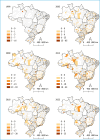Analysis of the Reduction in the Duration of Sick Leave for 32,512 Psoriasis Patients Following the Integration of Targeted Therapies for Psoriatic Disease into the Brazilian Healthcare System: a Retrospective Cohort Study
- PMID: 40171531
- PMCID: PMC11960484
- DOI: 10.2147/PTT.S513878
Analysis of the Reduction in the Duration of Sick Leave for 32,512 Psoriasis Patients Following the Integration of Targeted Therapies for Psoriatic Disease into the Brazilian Healthcare System: a Retrospective Cohort Study
Abstract
Purpose: The Brazilian Unified Health System is an interesting model for international healthcare innovation analysis. Covering over 200 million people, this system stands out as one of the largest purchasers of healthcare technologies worldwide. Our goal in this study was to evaluate how targeted therapies reduce the duration of sick leave for psoriasis patients.
Patients and methods: We conducted a retrospective cohort study within the Brazilian National Institute of Social Security. The primary outcome was the return to work (cessation of sick leave) of patients with psoriasis. Factors such as age, sex, and access to targeted therapies were evaluated using a Cox proportional hazards model.
Results: Over the 25-year period from 1998 to 2023, 32,512 benefits were granted for psoriasis, totalling an expenditure of $577,478,002.15. Public access to psoriatic arthritis (PsA)-targeted therapies decreased the average minimum wage granted to psoriasis patients on sick leave by 22%, and public access to psoriasis-targeted therapies reduced the average wage by 7%. The availability of these therapies was associated with earlier cessation of sick leave in our proportional hazards model (targeted therapies for PsA: hazard ratio (HR) = 1.90, 95% confidence interval (CI) = 1.82-2.00; targeted therapies for psoriasis: HR = 1.63, 95% CI = 1.54-1.70).
Conclusion: This study highlights a remarkable reduction in costs and sick leave duration due to the implementation of therapies for psoriatic disease by the Brazilian Unified Health System, which underscores the importance of considering detailed indirect cost data when evaluating new health technologies for large populations.
Keywords: arthritis; costs and cost analysis; health care costs; health expenditures; psoriasis; psoriatic.
Plain language summary
Psoriasis is a chronic inflammatory disease affecting more than 60 million people worldwide. The disease is known to affect genetically predisposed individuals after an environmental trigger, sparking a relentless cycle of skin and systemic inflammation. The Brazilian Unified Health System offers an interesting case study for analysing the financial implications of cutting-edge healthcare technologies. Serving over 200 million diverse individuals, it is one of the world’s largest single buyers of healthcare technologies. In the CLEAR and FIXTURE trials, compared with ustekinumab and etanercept, secukinumab not only demonstrated superior efficacy but also significantly reduced work impairment for patients and the associated indirect costs of psoriasis from weeks 16 through 52 in the United Kingdom. Although controlled clinical trials have illustrated the positive impacts of effective therapies for psoriasis, there is a considerable gap in real-world data. Our study examines the impact of targeted therapies on reducing the duration of sick leave for psoriasis patients, leveraging extensive big data analysis from the Brazilian National Institute of Social Security system. Our findings revealed a significant reduction in costs and sick leave durations owing to the implementation of these therapies for psoriatic disease. This study underscores a remarkable reduction in costs and sick leave duration due to the implementation of therapies for psoriatic disease by the Brazilian Unified Health System. This finding highlights the importance of considering detailed indirect cost data when evaluating new health technologies for large populations.
© 2025 D’Almeida et al.
Conflict of interest statement
Prof. Ciro Martins Gomes is a consultant, lecturer and/or researcher for Boehringer-Ingelheim, Janssen, Novartis and AbbVie. Prof Gleison Duarte is a consultant, lecturer and/or researcher for Boehringer-Ingelheim, Pfizer, Leo Pharma, Amgen, UCB, Sanofi Genzyme, Janssen, Novartis and AbbVie. Luiza Ferreira Vieira d’Almeida is a lecturer for Novartis and AbbVie. The authors report no other conflicts of interest in this work.
Figures





Similar articles
-
Secukinumab significantly reduces psoriasis-related work impairment and indirect costs compared with ustekinumab and etanercept in the United Kingdom.J Eur Acad Dermatol Venereol. 2018 Dec;32(12):2178-2184. doi: 10.1111/jdv.15094. Epub 2018 Jul 15. J Eur Acad Dermatol Venereol. 2018. PMID: 29846965 Free PMC article.
-
Employment is maintained and sick days decreased in psoriasis/psoriatic arthritis patients with etanercept treatment.BMC Dermatol. 2014 Aug 5;14:14. doi: 10.1186/1471-5945-14-14. BMC Dermatol. 2014. PMID: 25091090 Free PMC article. Clinical Trial.
-
Higher Psoriasis Skin Clearance Is Associated with Lower Annual Indirect Costs in the United States: A Post Hoc Analysis from the CLEAR Study.J Manag Care Spec Pharm. 2018 Jul;24(7):617-622. doi: 10.18553/jmcp.2018.24.7.617. J Manag Care Spec Pharm. 2018. PMID: 29952701 Free PMC article.
-
Trial Characteristics as Contextual Factors When Evaluating Targeted Therapies in Patients With Psoriatic Disease: A Meta-Epidemiologic Study.Arthritis Care Res (Hoboken). 2018 Aug;70(8):1206-1217. doi: 10.1002/acr.23455. Epub 2018 May 29. Arthritis Care Res (Hoboken). 2018. PMID: 29073353
-
The Minderoo-Monaco Commission on Plastics and Human Health.Ann Glob Health. 2023 Mar 21;89(1):23. doi: 10.5334/aogh.4056. eCollection 2023. Ann Glob Health. 2023. PMID: 36969097 Free PMC article. Review.
References
LinkOut - more resources
Full Text Sources
Research Materials
Miscellaneous

